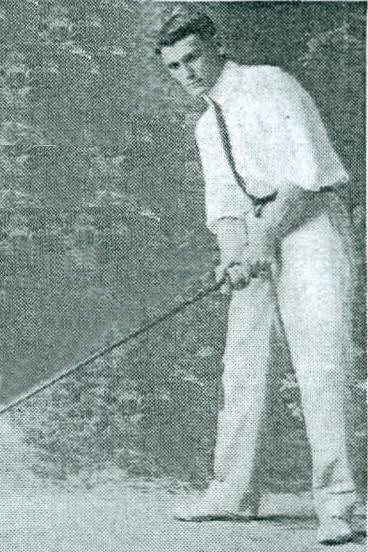The plot thickens...
As mentioned, Joe Bausch went to Phoenixville yesterday to play and to search for the "very old 3-ring binder". Alas, no luck there sadly.
Further, in discussions with the club he learned that they had contacted the wife of Mr. Weiland who passed last year and she didn't have it either. We may have reached a dead end and will likely never know the whole story without finding the binder, or at least be able to prove the whole story to everyone's satisfaction.
I also mentioned yesterday that I spent the morning going through the Minutes we do have for Phoenixville Country Club, which begin on May 2nd, 1915 at the dissolution of the "Golf Club" and creation of the new "Country Club". Also, as mentioned prior, the course had already been routed prior to that date on 56 acres of land the club had optioned.
One thing I learned over the past few days is that the actual growing in of the course was a multi-year process, interrupted by World War I. That war in itself has been problematic for golf course researchers, and we've seen in various cases where a course was routed by an architect prior only to open after the war, in some cases with the architect no longer involved. We've seen that in the case of Schuylkill and Ashbourne with Willie Park, for instance, where those courses were routed by Park in 1916 but didn't open until 1921 or so. In the case of Phoenixville, although the course was open to members for play at least some of the year (in seemingly pretty rough condition from the sounds of it) from probably 1917 on, it wasn't until 1920 when the club actually had their "coming out" party, so to speak, and invited two local pros to play an exhibition match against two top local amateurs, which I've covered in the articles Joe Bausch linked to above. Even then, the club still didn't have an irrigation system, a pro, or a superintendent.
However, in going through the minutes again later yesterday, I spied something that may be relevant to the creation story. As mentioned, the local papers on May 3, 1915 mentioned that the course had "already been laid out by a professional." Given that the writing was more attune to a local community paper than any sports writer who understood golf nuance, I didn't take it at face value, especially given Mr. Christman's recollection of the Hugh Wilson attribution in the old "Golf Club" minutes which he just reconfirmed for us last week. Here's the article;

Still, as I viewed the minutes the name sounded very familiar when I noted the last payment entry from the meeting of May 8th, 1915, as seen following;

Sure enough, some further digging confirmed my instincts and I reached out to Philadelphia PGA historian Pete Trenham to see what he knew about one James B. Hackney, one of four golf professional brothers who learned the game caddying at Carnoustie.
Here's what I was able to determine;
James (Jimmy) Hackney was first employed at the original Philadelphia Country Club course as an Assistant Pro from about 1909-11, then moved to Bala Golf Club from 1911-13 (his brother William took over for him at Bala in March 1915), then to Aronimink from 1914-17, to North Hills from 1918-20, then Green Valley from 21-22 and finally Merchantville (NJ) 23-24, all serving as Head Professional.
It should be noted that J. Whitaker Thompson, a federal judge and first President of Phoenixville Country Club was also a member of Bala Golf Club in 1912, so he almost certainly would have known Hackney. Thompson also later became a member of Merion Cricket Club, if only to confuse future researchers.

Seriously we're trying to establish the date he joined but know he was a member by 1922.
So, could the "Professional Services" that Hackney provided related to routing the golf course? We don't know, but it seems possible giving the timing. We have no record of Hackney ever involved with any design activities in the Philadelphia area, but that doesn't necessarily rule him out.
I've also started a thread here related to typical fees for golf pros designing courses at that time, trying to determine if the seemingly paltry amount of $17.80 was somewhat standard fare. Evidently that amount translates to about $414 in 2015 terms, which might be a decent day's pay depending on what he did. Even so, it seems more likely that a day's work routing a course might be some flat fee...what's with the .80 cents?
Or, could this have been for services provided to the former Phoenixville Golf Club during some of 1914? Might he have provided the golfers at that club lessons, or equipment, balls, and such? Perhaps this amount was simply to settle up any debt to him for services from the previous year? Again, finding the binder of the Phoenixville Golf Club would be invaluable in determining the full story.

Could it be that both stories are possible? Might these very well-connected rich guys have had a few folks up to view the proposed new property for its suitability as their future home? Certainly second opinions would be valuable, I'd think...perhaps even a few proposed routings to consider from different individuals might be prudent. It seems natural to consider.
I suspect that like most things around Philadelphia at that time, some degree of collaborative effort was involved, with a number of cooks over the broth, and it would seem to me that's the most likely scenario as I feel very confident that Mr. Christman's detailed recollections of Hugh Wilson's involvement are accurate, yet it's also clear that Wilson wasn't directly involved in the construction and grow-in phases, or at least the Minutes don't reflect his involvement.
In any case, it's a fascinating if somewhat frustrating story. We're hopeful that old binder will show up somewhere, someday.